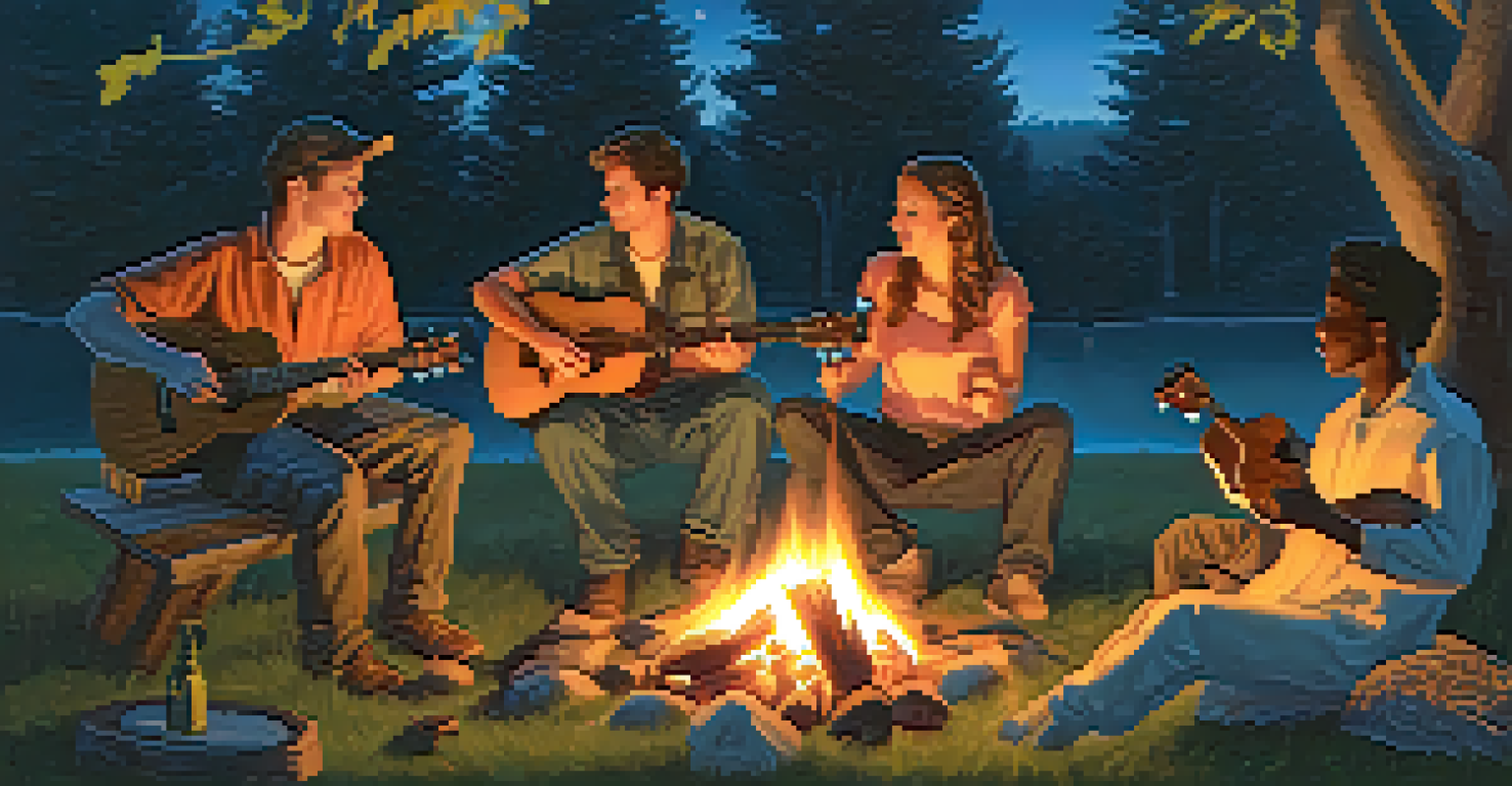Integrating Ukulele Music to Enhance Narrative Experiences

The Role of Music in Storytelling: An Overview
Music has always been a powerful tool in storytelling, setting moods and evoking emotions. Think about your favorite movie scenes; often, the music is just as memorable as the visuals. The right soundtrack can elevate a narrative, making it more impactful and memorable for the audience.
Music is the shorthand of emotion.
Incorporating music, especially something as light and cheerful as the ukulele, can create a unique atmosphere that enhances the overall experience. The ukulele’s bright, soothing tones can evoke feelings of nostalgia and warmth, making it a perfect companion for various narratives. By understanding the role of music, storytellers can better connect with their audience.
Ultimately, the integration of music into storytelling is about creating a multi-layered experience. It allows audiences to immerse themselves fully in the narrative, engaging not just their minds but also their hearts. This is where the ukulele can shine, adding a distinct flavor to any tale.
Why Choose the Ukulele for Narrative Enhancement?
The ukulele is often perceived as an instrument of joy and playfulness, making it a delightful choice for enhancing narratives. Its simple, melodic nature can evoke a sense of happiness that aligns beautifully with many storytelling themes. Moreover, its approachable sound can cater to a wide range of audiences, from children to adults.

Unlike heavier instruments, the ukulele brings a lightness to stories, which can be particularly effective in crafting whimsical or light-hearted narratives. For example, imagine a children's story where the ukulele underscores the adventures of a playful character; the combination creates an engaging atmosphere that captivates young listeners. This instrument can help create a whimsical and inviting backdrop for any tale.
Music Enhances Storytelling Impact
Incorporating music, especially the ukulele, creates a multi-layered experience that deeply engages audiences emotionally.
Additionally, the ukulele is versatile and can be easily adapted to various genres and moods. Whether it’s a romantic tale, a comedic adventure, or a reflective story, the ukulele’s sound can adjust to fit the narrative's tone, making it a unique asset for storytellers.
Creating a Soundtrack for Your Narrative
Crafting a soundtrack involves more than just playing notes; it’s about capturing the essence of the story. Start by identifying key moments in your narrative that could benefit from musical support. These moments can be emotional peaks, transitions, or even character introductions where music can amplify the experience.
The music can evoke feelings that align with your narrative's message.
Once you’ve pinpointed these moments, you can select ukulele melodies that resonate with the feelings you want to convey. For instance, a gentle strumming pattern can reflect a character's introspective moment, while a lively plucking rhythm might enhance a scene full of action and excitement. This thoughtful approach ensures that the music complements rather than distracts from the narrative.
Lastly, don’t hesitate to experiment with different styles and tempos. The beauty of the ukulele lies in its adaptability; you can find or create melodies that fit your story perfectly. By blending creativity with your narrative, you'll create a harmonious experience that captivates your audience.
Live Performances: Engaging the Audience
One of the most engaging ways to integrate ukulele music into storytelling is through live performances. Imagine a storyteller strumming the ukulele while narrating a tale; the audience is not just passive listeners but active participants in the experience. This interaction fosters a deeper connection between the story and its audience.
Live performances also allow for spontaneous moments that can enhance the narrative. For example, if a character faces a challenge, the storyteller can adjust the music in real-time to reflect the tension or excitement. This dynamic relationship between storytelling and music creates a memorable experience that resonates with the audience long after the performance ends.
Ukulele Adds Joy to Narratives
The ukulele's cheerful sound makes it an ideal choice for uplifting stories, appealing to audiences of all ages.
Moreover, incorporating audience participation can amplify the experience even further. Encouraging the audience to join in singing a catchy chorus or clapping along can turn a simple narrative into an unforgettable event. This communal aspect of storytelling combined with ukulele music creates an atmosphere of joy and connection.
Digital Storytelling: Incorporating Ukulele Music
In the digital age, storytelling has found new platforms, and integrating ukulele music can enhance these experiences. Whether it’s creating videos, podcasts, or interactive web stories, the ukulele can add a unique touch that sets your narrative apart. Think about how a cheerful ukulele tune can make a tutorial video more engaging and enjoyable.
Using ukulele music in digital storytelling involves more than just adding background sound; it’s about creating an emotional connection with your audience. As viewers or listeners engage with your content, the music can evoke feelings that align with your narrative's message. This emotional resonance can lead to a more lasting impact.
Additionally, platforms like social media allow for short bursts of storytelling where the ukulele can play a prominent role. A quick, catchy ukulele jingle can capture attention and convey your story's essence in mere seconds. This adaptability makes the ukulele an invaluable tool for modern storytellers.
Case Studies: Successful Integrations of Ukulele Music
Examining case studies of successful integrations of ukulele music can provide valuable insights. Many creators have harnessed the instrument's charm to enhance their narratives, from children's books to animated films. For instance, an animated short film featuring a ukulele soundtrack created a joyful atmosphere that perfectly matched the whimsical visuals.
Another example is a popular YouTube channel that uses the ukulele to accompany their storytelling segments. The cheerful and inviting sound of the instrument has helped the channel garner a loyal following, demonstrating the power of music in enhancing engagement. These case studies show how effective the ukulele can be in capturing and maintaining audience interest.
Live Performances Foster Engagement
Integrating live ukulele music into storytelling creates an interactive experience, enhancing audience connection and enjoyment.
By analyzing these successful integrations, aspiring storytellers can learn how to use the ukulele to their advantage. They can identify elements that resonate with audiences and adapt those strategies to fit their narratives. Ultimately, these examples serve as inspiration for anyone looking to enrich their storytelling with music.
Final Thoughts: The Future of Ukulele in Storytelling
As storytelling continues to evolve, the role of music, particularly the ukulele, will remain significant. The instrument's unique sound and versatility make it an ideal choice for a wide range of narratives. Whether in traditional storytelling settings or modern digital formats, the ukulele has the potential to enhance experiences in new and exciting ways.
Looking ahead, we can expect to see more storytellers embracing the ukulele in various formats, from live performances to multimedia projects. The ongoing fusion of music and narrative will continue to captivate audiences and create memorable experiences. This trend reinforces the idea that storytelling is an art form that thrives on innovation and creativity.

In conclusion, integrating ukulele music into narrative experiences offers a delightful opportunity to engage audiences on multiple levels. As you explore the possibilities of this charming instrument, remember that the goal is to create a harmonious relationship between music and storytelling, enriching the journey for both you and your audience.